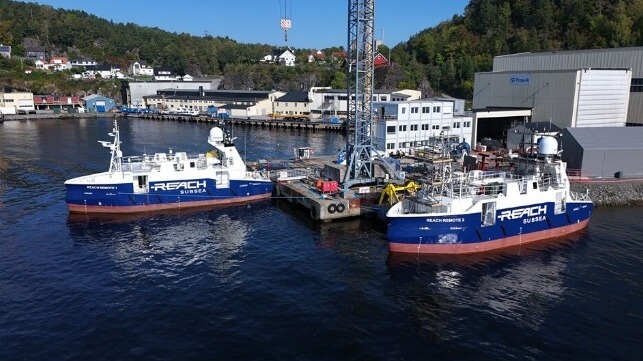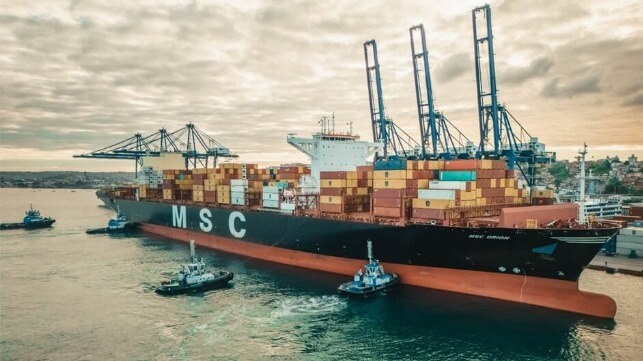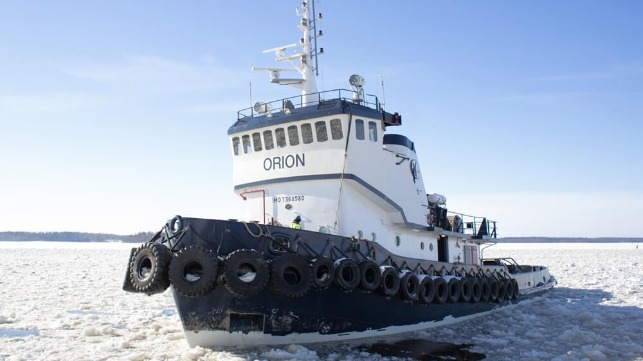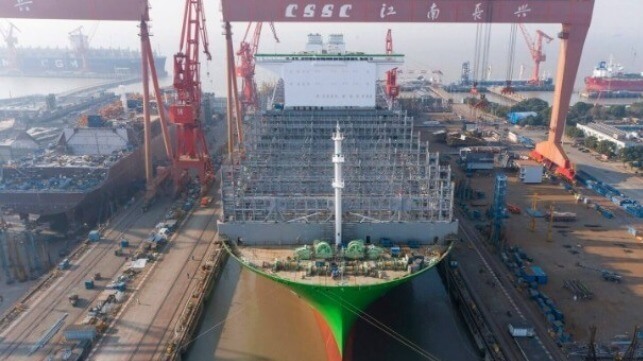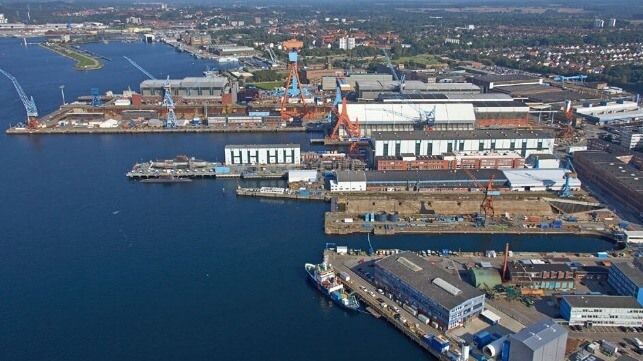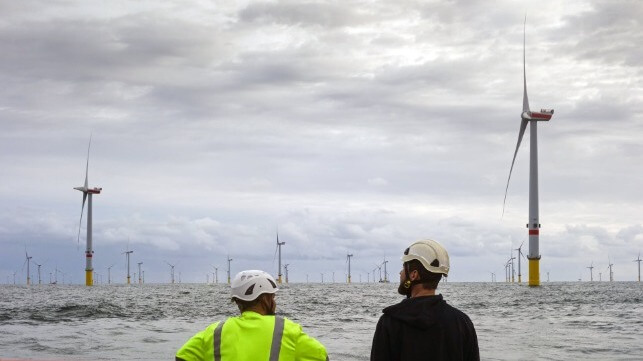Hina Alam
Tue, October 22, 2024


FREDERICTON — New Brunswick voters have elected a Liberal majority government, tossing out the incumbent Progressive Conservatives after six years in power and handing the reins to the first woman ever to lead the province.
Liberal Leader Susan Holt is a relative newcomer to the province’s political scene, having won a byelection last year, eight months after she became party leader.
"Tonight's results make it clear that New Brunswickers are ready for a change," she told a boisterous crowd of supporters in downtown Fredericton on Monday night during an energetic speech that showed off her skills as a fluently bilingual premier-designate.
"We don't take it lightly that you have put your trust in myself and my team and that you have hope for a brighter future."
Flanked by her three young daughters, Holt paid tribute to several women who were trailblazers in provincial politics, including former NDP leader Elizabeth Weir and Aldéa Landry, the first Acadian woman in New Brunswick named as a cabinet minister.
"This is something that I have wanted for someone else for a long time," Holt said after her victory speech. "I’ve been waiting to see this achievement in New Brunswick … and it blows my mind that it’s me — that is the first woman premier of New Brunswick.”
The 47-year-old former business advocate and public servant led the Liberals to victory after a 33-day campaign, thwarting Blaine Higgs’s bid to secure a third term as Tory premier. The Liberal win marks a strong repudiation of Higgs’s pronounced shift to more socially conservative policies.
"After six years of Blaine Higgs leadership, the province has said enough is enough," said Donald Wright, a political science professor at the University of New Brunswick in Fredericton. "I think they are very tired of his top-down bullying and, at times, mean-spirited leadership."
Among other things, Wright said voters were turned off by Higgs's "negative rhetoric" about the use of pronouns and names by young transgender students, and his decision to reject all new applications for supervised drug-consumption sites.
As well, Higgs's decision to repeatedly bash Prime Minister Justin Trudeau also failed to resonate with voters, though he said it remains unclear what the federal Liberals could learn from Monday's results.
"I think this election had its own logic, its own dynamic," Wright said. "I don't know if it's translatable to the federal scene."
With all of the polls reporting, the Liberals won 31 of the legislature's 49 seats. The Conservatives had 16 and the Greens two.
When the Liberal win was announced, Holt's supporters stood and roared their approval. Amid the cheers and whistles, some women, including Landry, used tissues to wipe tears from their eyes.
"It means the world to me," said Landry, who also served as deputy premier under former Liberal premier Frank McKenna. "It's a milestone for the province."
Trudeau congratulated Holt on social media, saying the pair would work together "to build more homes, protect our official languages, and improve health care for New Brunswickers."
Higgs, meanwhile, lost in the southern New Brunswick riding of Quispamsis. In a speech to supporters in the riding, he confirmed that he would be stepping down after a leadership transition process.
"It's certainly not the night we hoped for," Higgs told the crowd at the St. Louis Bar and Grill in a strip mall. "Nevertheless, it is what it is. The people of New Brunswick have spoken."
During his speech after he won his riding of Fredericton Lincoln, Green Party Leader David Coon pledged to continue building the party, but he then turned his sights on Higgs. "One thing is for sure," he told the crowd at Dolan’s Pub in Fredericton. "We know that Blaine Higgs is no longer the premier of this province." The audience responded with raucous cheers.
The election race was largely focused on health care and affordability but was notable for the remarkably dissimilar campaign styles of Holt and Higgs.
The 70-year-old Tory leader, a mechanical engineer and former Irving Oil executive, led a low-key campaign, during which he didn't have any scheduled public events on at least 10 days — and was absent from the second leaders debate on Oct. 9.
Holt missed only two days of campaigning and submitted a 30-page platform with 100 promises, a far heftier document than the Tories’ two-page platform that included 11 pledges. As well, Holt repeatedly promised to bring a balanced approach to governing, pledging a sharp contrast to Higgs’s “one-man show taking New Brunswick to the far right."
“We need a government that acts as a partner and not as a dictator from one office in Fredericton,” she said in a recent interview with The Canadian Press.
As well, Holt spent much of the campaign rolling out proposed fixes for a health-care system racked by a doctor shortage, overcrowded emergency rooms and long wait-times. She promised to open 30 community health clinics across the province by 2028.
The Tory campaign was focused on the high cost of living, with Higgs promising to lower the provincial harmonized sales tax by two percentage points to 13 per cent.
When the election was called on Sept. 19, the Conservatives held 25 seats, the Liberals held 16 seats, the Green Party had three, there was one Independent and four vacancies.
Higgs was hoping to become the first New Brunswick premier to win three consecutive elections since Liberal Frank McKenna won his third-straight majority in 1995. But it was clear from the start that Higgs would have to overcome some big obstacles.
On the first day of the campaign, a national survey showed he had the lowest approval rating of any premier in the country. That same morning, Higgs openly mused about how he was perceived by the public.
“I really wish that people could know me outside of politics,” he said, adding that a sunnier disposition might increase his popularity. “I don’t know whether I’ve got to do comedy hour or I’ve got to smile more.”
Still, Higgs had plenty to boast about, including six consecutive balanced budgets, a significant reduction in the province’s debt, income tax cuts, a booming population and a $1-billion infusion of funds into the health-care system.
But internal party strife dragged down his popularity. Since 2020, at least 12 Tory caucus members stepped down after clashing with the premier, some of them citing what they described as an authoritarian leadership style and a focus on conservative policies that represented a hard shift to the right.
This report by The Canadian Press was first published Oct. 21, 2024.
-- With files from Lyndsay Armstrong in Quispamsis, N.B., and Michael MacDonald in Halifax
Hina Alam, The Canadian Press
CBC
Tue, October 22, 2024

Premier-elect Susan Holt gives media interviews after historic win Monday night. (Patrick Morrell/CBC - image credit)
It's been less than 24 hours since New Brunswickers delivered a decisive win to Susan Holt's Liberals and a devastating loss to Blaine Higgs's Progressive Conservatives.
But a day is a long time in politics, and political pundits are already examining what happened during the campaign and and what may be to come.
One thing that is clear is that the Liberals managed to keep Holt in the spotlight and the party branding to the sidelines.
"I don't think this is a sign that the Liberals' luck at the federal level is turning," said Erin Crandall, an Acadia University political scientist.
"I think what we saw was a party that was effective in disassociating their Liberal Party from the federal Liberal brand, right, and so part of that was emphasizing Team Holt."

In campaign signs and literature, including the platform, the Liberal party focused more on their leader than the party.
In campaign signs and platform literature, the Liberals focused more on their leader than the party. (Liberal Party of New Brunswick)
J.P. Lewis, a political scientist at UNB Saint John, said the Liberals were shrewd in making that break and their concern about potential drag from the Trudeau brand was not overplayed.
"I think they did a good job of running away from it," said Lewis.
"They figured out a way to make this about Blaine Higgs and about Susan Holt … and they kept the Liberal brand out of it."
PCs fail to keep up
While the Liberals had an extensive platform and offered several major promises, the PCs took the opposite approach with a two- page platform that largely spoke to their record.
St. Thomas University political scientist Jamie Gillies believes that was a mistake in this campaign.
"I think the the challenge here was that you do have to promise voters something. You have to campaign for the future, and they were campaigning on the past and that did not work," Gillies said.

Progressive Conservative leader Blaine Higgs exiting his campaign bus, witch is emblazoned with the party's promise to cut the HST by two per cent.
PC Leader Blaine Higgs focused on his record and a handful of commitments, such as a cut to the HST. (Jacques Poitras/CBC)
Political columnist and former journalist Duncan Matheson said he agreed with the PC strategy of trying to tie Holt to Trudeau, but in the end even that didn't work.
He thinks it was a case of Holt a running a good campaign, while Higgs did not.
"It was a weak campaign in my estimation," said Matheson.
Mixed bag for Greens
While the Green Party more or less maintained its vote, it lost a third of its caucus.
Gillies said the party should see this as a win because this turned out to be a change election, not something that is beneficial to third parties.
"Third parties often do poorly because the wave favours one of the two major parties.

Green Leader David Coon, standing with his wife Janice Harvey and daughter Caroline Coon speak to supporters in Fredericton after he was projected to win his riding.
It was a mixed night for the Greens who managed to maintain their position in votes, but lost a third of their caucus. (Kate Letterick/CBC)
Crandall said that while the Greens did lose one seat, the two races they won have solidified the party's standing, and it can now be seen as a natural third party of New Brunswick.
"The Green Party now kind of occupies the political left in New Brunswick," said Crandall.
"This election confirms that the Green Party is here to stay."
Next steps for the Liberals
For the Liberals, it's just the start of what is expected to be a four-year government.
There are election promises to keep and an expanded roster of MLAs, who may all think they deserve to get a cabinet post.
Matheson said the Liberals have a lot on their plate.
"Fixing health care is going to be massive. She promised a lot on that. Look at the financial problems N.B. Power is facing. You know, billions of dollars. She's got her work cut out for her," said Matheson.
Crandall expects the change in government will mean a change in the rhetoric coming out of the legislature, to "probably ... create a friendlier politics."
"I think we're going to see a change in the way leaders in New Brunswick … talk about politics, talk about the way we should be doing politics," said Crandall.
Next steps PCs
For the Progressive Conservatives, the loss means a number of things, including a potential new leader and taking a hard look at why the election plaid out the way it did.
That won't be easy, said Lewis, considering some of the losses the PCs faced Monday night.
"This is like that team that has gotten rid of all the big contracts and completely rebuilt," he said.

Supporters of New Brunswick Progressive Conservative Party Leader Blaine Higgs watch results at a bar during the provincial election in Quispamsis, N.B. Higgs lost his seat to Liberal Aaron Kennedy. Five other PC cabinet ministers lost their seats.
Progressive Conservatives now have to face the search for a new leader and what direction their party will take. (The Canadian Press)
The PCs "lost the front bench," including cabinet ministers Greg Turner, Ernie Steeves, Ted Fleming, and Blaine Higgs himself.
"It'll be really interesting to see who comes out to put their name forward for leadership," said Lewis.
Gillies expects there will be a "fight for the soul of the party."
The "PC brand in the four eastern-most provinces is still very strong," he said.
"This social conservative and, sort of, phoned-in Christian nationalist message that they ran over the last year did not work.
"It didn't work for voters. It didn't work for the public. And Blaine Higgs paid a price last night."
Michael MacDonald
Mon, October 21, 2024

FREDERICTON — After her party won a majority government in the New Brunswick election on Monday, Liberal Leader Susan Holt thanked all the women who came before her.
Flanked by her three young daughters on stage in Fredericton, Holt, the first female premier-designate in New Brunswick history, delivered a bilingual victory speech that paid tribute to female trailblazers in provincial politics.
The 47-year-old former business advocate and public servant led the Liberals to victory after a 33-day campaign, thwarting Blaine Higgs’s bid to secure a third term as Tory premier.
Aside from her tough-talking style, the 47-year-old party leader from Fredericton is known for her varied work history, which includes stints in the private and public sectors.
Her first job was scooping ice cream at a gas station in Fredericton before she was promoted to cashier at a nearby grocery store. She later worked for other local entrepreneurs, including an engineering firm and some IT startups. She went on to management roles within large IT firms, including IBM, Xerox, HP and Research In Motion.
Before entering the political arena, Holt served as CEO of the Fredericton Chamber of Commerce and CEO of the New Brunswick Business Council. A graduate of Queen’s University in Kingston, Ont., she has also worked as a business lobbyist and consultant.
After working as an adviser to former Liberal premier Brian Gallant, Holt won the provincial Liberal leadership in August 2022. She was elected to the legislature in an April 2023 byelection, representing a largely rural riding in northern New Brunswick. At the close of the latest campaign, she won a riding in Fredericton
Holt has repeatedly drawn attention to what she has described as Higgs's top-down leadership style.
"We've seen that Blaine Higgs can't work with anyone," Holt said in a recent interview with The Canadian Press, noting that 14 of his caucus members have quit their posts since the Tories won a majority in 2020 — several of them openly complaining about how the premier ran the government.
"He's a my-way-or-the-highway, one-man show," Holt said. "And that's not good for New Brunswickers."
She said Higgs, a former Irving Oil executive, had shifted his party towards more conservative policies. She cited his decision last year to require teachers to ask parents before they use the preferred pronouns of transgender students under 16 and promised a Liberal government would change that policy.
Holt has pledged to implement changes recommended in a report released last year by Kelly Lamrock, the province's child and youth advocate. Lamrock said children in Grade 6, who are around the age of 12, should be allowed to make the decision without parental consent.
As for the campaign, it was a lacklustre affair, perhaps most notable for the Progressive Conservative leader's decision not to take part in any scheduled public events during at least 10 days of the race.
Still, it wasn't an easy ride for Holt. Last week, she was on the defensive for comments she made about residents in her former riding in northern New Brunswick.
In January, Holt was describing the diversity of the province when she told a podcast that in Fredericton there were "really progressive people here, highly educated … and my riding of Bathurst East-Nepisiguit-Saint-Isidore has (a) totally different makeup."
In response, the Progressive Conservatives released a campaign ad that accused the Liberal leader of suggesting Bathurst residents were not as smart as people in the capital.
Holt acknowledged she should have been more careful with her words. "It's always a lesson that you have to speak carefully because there are people out there who will want to twist your words … for political gain," she said in the interview.
The Liberals focused much of their campaign on improving the province's health-care system. Holt said the topic dominated discussion at the doorstep.
"People are legitimately afraid to go to an ER because they might be waiting there for 12 hours," she said. "Our health-care system is in crisis."
The Liberals are pledging to build at least 30 community care clinics across the province over three years, bringing together doctors, nurses and other health professionals under one roof. Holt has said doctors are eager to work in such clinics because the administrative support can free them from paperwork and other time-consuming tasks.
Asked how she felt about the possibility of making history as the province's first female premier, Holt said: "I thought we would get here before now."
Then she turned attention to her daughters, ages 12, 10 and seven.
"It's pretty surreal to think that I might show them that this particular glass ceiling can be broken and there won't be barriers to what they can achieve in their lives," she said.
This report by The Canadian Press was first published Oct. 21, 2024.
Michael MacDonald, The Canadian Press
Mon, October 21, 2024

Green Leader David Coon, standing with his wife, Janice Harvey, and daughter, Caroline Coon, speaks to supporters in Fredericton after he was projected to win his riding. (Kate Letterick/CBC - image credit)
The New Brunswick Green Party has been reduced from three to two seats, with the loss of Kent North incumbent Kevin Arseneau.
But it was a jubilant David Coon, leader of the Greens, who spoke to supporters in Fredericton on Monday night.
And while he was unhappy over Arseneau's loss, he said it was time to get back to work and hold the Liberals accountable.
The crowd started cheering and chanting when Coon mentioned PC Leader Blaine Higgs, who lost to Liberal Susan Holt, now the premier-designate.
Coon won his riding of Fredericton-Lincoln with a strong lead of 44.5 per cent of the vote, as of 9:30 p.m. AT. PC candidate Daniel Chippin came second at 28.1 per cent, with Liberal candidate Joni Leger third, at 27.4 per cent.
Megan Mitton handily won her riding of Tantramar, beating Liberal candidate John Higham, a former mayor of Sackville. Mitton was at 48.9 per cent of the vote, as of 9:30 p.m., while Higham was at 25.3 per cent.
Arseneau garnered 37.1 per cent of the vote in his riding, compared to Liberal Pat Finnigan with 44.8 per cent. Finnigan is a former Liberal MP.
"What a surprise tonight," Coon said at his victory speech as he thanked voters in his riding.
"By now we all know Kevin [Arseneau] is not going back to the legislative assembly, and that's a sad and terrible thing for New Brunswick."
The crowd cheered loudly as Coon thanked Arsenau, who was elected in 2018, for his work as MLA.
Coon spoke in English and French, lauding what was the party's only Acadian member, calling him a "real leader" in comments translated from French.

Green Party MLA Kevin Arseneau speaking to reporters in the New Brunswick legislature.
Green Party MLA Kevin Arseneau lost his seat in Kent North. (Michel Corriveau/Radio-Canada)
"I know we'll find a role for him and he'll find a role after the election," Coon said in English.
The party failed to make any advances. One of the candidates they felt had a strong chance to win was Serge Brideau in Tracadie, but he came second at 40.8 per cent, as of 10 p.m., compared with Liberal winner and incumbent Keith Chaisson at 53.5 per cent.
Simon Ouellette, who challenged Liberal Leader Susan Holt in Fredericton South-Silverwood, came third at 20.2 per cent, as of 10 p.m., behind PC candidate Nicolle Carlin at 24.7 per cent.
"It's so hard to try and win a seat in this election, and I don't know what to say, it's heartbreaking, I know when you pour your blood and sweat and tears into winning that seat," said Coon.
But the loudest applause came when Coon announced Higgs was no longer premier, as the crowd erupted and started chanting, "Na na na na, goodbye."
Coon said he called Holt to congratulate her.
He said it's his party's responsibilityto push them to make them necessary investments, fix the health-care system and "serve New Brunswickers in the way they need to be served."
CBC
Mon, October 21, 2024

Liberal supporters and campaign staff erupted into cheers when results were finalized, signaling a win for John Herron, who was also celebrating a birthday. (Nipun Tiwari/CBC - image credit)
Liberal John Herron has won Hampton-Fundy-St. Martins in a close race against Christian activist candidate Faytene Grasseschi, who some say signaled a potential turning point for New Brunswick's Progressive Conservative party.
Herron, a former Progressive Conservative MP, said it was a major win that reflects the progressive nature of the community — with what he called a history of traditionally moderate politics.
"You had a great number of individuals within this community who checked their past partisan storage at the door, where we had Progressive Conservatives, Liberals —even voters who may be more Green-inspired — and they've all joined this particular candidacy," he said.
Liberals won the riding with 3,259 votes by a margin of 2.7 per cent, the PCs garnered 3,035 votes.
"I think there's a number of things for consideration, given that Mr. Higgs had well over 10 of his own MLAs not offering for him again, I think there were very strong signals that the governing party was apt to change," Herron said.
"To elect a member who's going to participate in that new government — that's absolutely helpful to the region itself."
The Liberal party won a majority with 31 seats, making leader Susan Holt the first woman to be premier in the province's history. The PC party won 16 seats and the Green party won 2.

She was not available for comment once results in her riding were finalized. She released a Facebook post thanking her team and supporters and congratulated John Herron on his win.
Faytene Grasseschi was not available for comment once results in her riding were finalized. She released a Facebook post thanking her team and supporters, and congratulated John Herron on his win. (CBC)
Grasseschi has been a Christian activist for two decades and has been accused of harbouring extreme views on issues such as gay rights and abortion.
She previously said she put her name forward in response to a "party revolt," and what she called an assault "by the liberal media" over Higgs's changes to Policy 713, an education policy requiring students under 16 to obtain parental consent before teachers using a new name or pronoun aligning with their gender identity.
She was nominated as the candidate for the riding over the objections of Gary Crossman, who held the riding for many years but decided not to reoffer, and members of the PC riding association board.
Early in her campaign, she said her opponents had denigrated her for things she said two decades ago. She also said she believes in the Charter of Rights and Freedom.
CBC News contacted Grassechi's campaign office for comment Monday night. A campaign staff member said Grassechi and her campaign were hosting a gathering at a private residence on the night of the election.
She was not available for comment once the results were finalized.
In a Facebook post, Grassechi thanked her supporters and campaign team and congratulated Herron on his victory.

Green candidate Laura Myers congradulated Liberal candidate John Herron on his win and said she is happy with the progress the Green party has made in the riding.
Green candidate Laura Myers congradulated Liberal John Herron on his win and said she's happy with the progress the Greens have made in the riding. (Jacques Poitras/CBC)
Counts in the region were delayed by voting machine failures at the Hampton Community Library polling location. Results came a few hours after the Liberals won a majority.
The Green Party came in third in the riding, winning 18.7 per cent of the vote.
Laura Myers, who previously said the PCs should have rejected Grasseschi's bid to run, stopped by Herron's campaign headquarters to congratulate him.
"The people spoke — they wanted change," she said.
"I think that the Conservative candidate that was chosen for this riding was somebody that the people in the riding just couldn't back. And so they wanted something different. And I think that the Liberal vote, it was a safer vote."
Myers said she feels good about the progress the Green Party has made in the riding.
"I mean, the last election we had under 13 per cent in this riding and this time we had almost 19 per cent. So that's a pretty big jump. I'm very proud of the campaign that we ran," she said.
Liberals pick up key ridings on path to majority government
CBC
Mon, October 21, 2024

Susan Holt made history as the first woman to be elected premier of New Brunswick. (Patrick Morrell/CBC News - image credit)
New Brunswick's Liberals have flipped key ridings across New Brunswick from blue to red, on the way to a majority win.
Several ridings in the province's cities were seen as key for the Liberals to gain back from Blaine Higgs's Progressive Conservatives, which achieved a majority in 2020.
But the tide turned Monday night with New Brunswick electing a majority Liberal government and Liberal Leader Susan Holt as the first woman to become premier of the province.
Even the premier, Blaine Higgs, lost his seat in Quispamsis, to Liberal Aaron Kennedy.
"I love you, I love you New Brunswick," Holt said in a victory speech. "With me, you're going to get a leadership that listens, and a leadership that cares. A leadership that will respect you."

Progressive Conservative Leader Blaine Higgs lost his Quispamsis seat to Liberal Aaron Kennedy.
Progressive Conservative Leader Blaine Higgs lost his Quispamsis seat to Liberal Aaron Kennedy. (CBC)
Several Higgs-era cabinet ministers, including Ted Flemming of Rothesay, Ernie Steeves of Moncton Northwest, and Fredericton North's Jill Green were unseated by Liberal contenders Alyson Townsend, Tania Sodhi, and Luke Randall, respectively.
Sodhi was one of few candidates of colour on the ballot in 2024.
"I had amazing candidates that clearly New Brunswickers responded to and elected," Holt said in an interview with CBC News.
Aldéa Landry, deputy premier to Frank McKenna and a key supporter of Holt in the Liberal leadership race, held back tears speaking with CBC News after the result came in.
"It's her-storical," Landry said, "The province is 240 years old, and our first woman premier."
While southern ridings voted decisively for Higgs's PCs in 2020, nearly all Saint John ridings turned red.
Liberal candidate and former city councillor David Hickey and Dr. John Dornan, who won a wrongful dismissal case against the Higgs government, were able to convert Saint John Harbour and Saint John Portland-Simonds.

Aldéa Landry, who made history as deputy premier to Frank McKenna, called Monday's election result "her-storical." (CBC)
"It came down to our team," Hickey said in an interview. "It's been resounding tonight, and for that we're incredibly thankful."
Kate Elman Wilcott took Saint John West-Lancaster, while PC-turned-Liberal John Herron won his race against controversial candidate Faytene Grasseschi.
"The tone … was that people were ready for a fresh start on Tuesday morning," Elman Wilcott said of her experience campaigning door-to-door.
Higgs cabinet minister Glen Savoie was the only PC in the region to hold onto his seat in Saint John East, after a nail-biter race with Liberal David Alston.
The Liberals were also able to make inroads in Fredericton South-Silverwood and Fredericton North, with Holt projected to win her seat in the former and Luke Randall unseating former Higgs' minister Jill Green.
Hanwell-New Maryland also went red with Cindy Miles coming out ahead in a race against New Maryland mayor Judy Wilson-Shee.
Claire Johnson, Alexandre Cédric Doucet and Lyne Chantal Boudreau were able to take key seats in Moncton South, Moncton East, and the new riding of Champdoré-Irishtown. Incumbent Rob McKee handily kept his seat in Moncton Centre.

Liberal Leader Susan Holt focused mostly on affordability and healthcare in her speech to a crowd in Fredericton.
Liberal candidates in all three New Brunswick cities were able to flip key ridings. (Gilles Landry/Radio-Canada)
The party also made progress in Miramichi, with Sam Johnson unseating PC incumbent Réjean Savoie.
Liberal candidate and former member of Parliament Pat Finnigan unseated Green MLA Kevin Arseneau.
Voters returned several Liberal MLAs back to the legislature, including Francine Landry, René Legacy, Isabelle Thériault, Jean-Claude D'Amours, Keith Chiasson, Guy Arseneault, Jacques LeBlanc, Éric Mallet, Marco LeBlanc, Robert Gauvin, Gilles LePage, Benoît Bourque, and Chuck Chiasson.
Local government leaders were in attendance at the Liberal celebration in Fredericton, including Sitansisk Chief Allan Polchies Jr. and Fredericton Mayor Kate Rogers.
New Brunswick Liberal Association executive director Hannah Fulton-Johnson told CBC News the party had been hopeful heading into Monday's decision.
"We've run a very positive campaign focused on what matters to New Brunswickers, which is better health care where and when you need it, affordability," she said.
"I think that resonates all across the province, not in any particular region."












